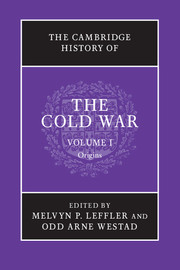Book contents
- Frontmatter
- 1 The Cold War and the international history of the twentieth century
- 2 Ideology and the origins of the Cold War, 1917–1962
- 3 The world economy and the Cold War in the middle of the twentieth century
- 4 The emergence of an American grand strategy, 1945–1952
- 5 The Soviet Union and the world, 1944–1953
- 6 Britain and the Cold War, 1945–1955
- 7 The division of Germany, 1945–1949
- 8 The Marshall Plan and the creation of the West
- 9 The Sovietization of Eastern Europe, 1944–1953
- 10 The Cold War in the Balkans, 1945–1956
- 11 The birth of the People’s Republic of China and the road to the Korean War
- 12 Japan, the United States, and the Cold War, 1945–1960
- 13 The Korean War
- 14 US national security policy from Eisenhower to Kennedy
- 15 Soviet foreign policy, 1953–1962
- 16 East Central Europe, 1953–1956
- 17 The Sino-Soviet alliance and the Cold War in Asia, 1954–1962
- 18 Nuclear weapons and the escalation of the Cold War, 1945–1962
- 19 Culture and the Cold War in Europe
- 20 Cold War mobilization and domestic politics: the United States
- 21 Cold War mobilisation and domestic politics: the Soviet Union
- 22 Decolonization, the global South, and the Cold War, 1919–1962
- 23 Oil, resources, and the Cold War, 1945–1962
- Bibliographical essay
- Index
- References
20 - Cold War mobilization and domestic politics: the United States
Published online by Cambridge University Press: 28 September 2010
- Frontmatter
- 1 The Cold War and the international history of the twentieth century
- 2 Ideology and the origins of the Cold War, 1917–1962
- 3 The world economy and the Cold War in the middle of the twentieth century
- 4 The emergence of an American grand strategy, 1945–1952
- 5 The Soviet Union and the world, 1944–1953
- 6 Britain and the Cold War, 1945–1955
- 7 The division of Germany, 1945–1949
- 8 The Marshall Plan and the creation of the West
- 9 The Sovietization of Eastern Europe, 1944–1953
- 10 The Cold War in the Balkans, 1945–1956
- 11 The birth of the People’s Republic of China and the road to the Korean War
- 12 Japan, the United States, and the Cold War, 1945–1960
- 13 The Korean War
- 14 US national security policy from Eisenhower to Kennedy
- 15 Soviet foreign policy, 1953–1962
- 16 East Central Europe, 1953–1956
- 17 The Sino-Soviet alliance and the Cold War in Asia, 1954–1962
- 18 Nuclear weapons and the escalation of the Cold War, 1945–1962
- 19 Culture and the Cold War in Europe
- 20 Cold War mobilization and domestic politics: the United States
- 21 Cold War mobilisation and domestic politics: the Soviet Union
- 22 Decolonization, the global South, and the Cold War, 1919–1962
- 23 Oil, resources, and the Cold War, 1945–1962
- Bibliographical essay
- Index
- References
Summary
As United States policymakers charted a more aggressive internationalism at the end of World War II, it was not immediately clear how ordinary Americans might be affected by this new course. Early Cold War blueprints mentioned a role for civilians in the emerging East–West conflict, but this amounted to fervent but still fuzzy calls for heightened public interest in current events. As US–Soviet relations grew chillier, Cold War architects such as George Kennan sermonized that morally flabby Americans would have to strengthen their civic muscles and “measure up” to earlier generations of revolutionary Americans whose courage and commitment had preserved the nation. In more muted and sterile policy parlance, other Cold Warriors grimly foretold a future of higher taxes, cuts in nondefense spending, and the restraint of civil liberties for the promise of internal security. By 1950, however, a National Security Council policy paper, NSC 68, warned more starkly that the Cold War was not merely a clash of ideologies but rather “a real war in which the survival of the free world [was] at stake.” To meet the challenge, Americans would have to summon their better selves and demonstrate their “ingenuity, sacrifice, and unity.”
Such were the stakes for mid-century Americans, but few of them readily understood their new civic burdens. National security planners talked more to one another than to their publics, and much of this early reflection about the Cold War’s domestic impact would be held closely within policy circles. And yet, to get the needed public engagement, presidents and a vast array of military and civilian administrators had to somehow translate and disseminate these plans to American citizens. From the immediate postwar years to the early 1960s, policymakers tasked the Cold War’s home-front institutions — state and local governments, schools, businesses, labor unions, civic organizations, and media — with the same objective of containment they would pursue at higher levels through military and covert means. The job was formidable: how could they popularize national security goals in a civilian vernacular? How could they reorient a nation-state around national security objectives while still maintaining the legal, economic, and cultural traditions that most citizens identified as “the American way of life”? Even NSC 68 acknowledged that the American people and American institutions would have to be mobilized through a “traditional democratic process” that respected basic values and institutions and the slower tempo of consensusbuilding.
- Type
- Chapter
- Information
- The Cambridge History of the Cold War , pp. 420 - 441Publisher: Cambridge University PressPrint publication year: 2010
References
- 2
- Cited by



